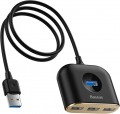PC connectivity
—
USB A. A classic, mainstream USB port that has recently been losing ground to the more advanced USB-C port.
—
USB-C. This connector differs from the classic, full-sized USB in much smaller dimensions, as well as a two-sided design that allows you to insert the plug in either direction. This interface is rarely found in desktop PCs, but is becoming increasingly popular in laptops, tablets, and phones. Note that the Type C standard only describes the connector design; The USB version (interface) is described in the paragraph below.
—
Lightning. Apple's proprietary interface used in its compact devices (iPhone, iPad, and iPod touch) since 2012. In terms of application features, it is completely similar to the microUSB described above, adjusted for the fact that it is found only in “apple” gadgets and is not used by other manufacturers.
— Internal USB. A variation of the USB standard used to connect internal card readers (see "Type", "Destination"). It differs from external USB in a connector; you can connect a card reader with such a connection only to the connectors on the motherboard; it is not compatible with external USB ports. Other characteristics are completely similar to the corresponding external USB standard (see above).
—
microUSB. A reduced version of the external USB interface (see a
...bove): the dimensions of such a connector are several times smaller than those of a full-sized one, which allows it to be used in portable equipment, in particular smartphones and tablets. Actually, card readers and hubs that use this interface to connect are usually designed for such equipment. Note that normal operation is possible only if the main device is capable of operating in USB host mode (this function is called USB On-the-Go).
— Wi-Fi. A wireless standard originally developed as a technology for building computer networks; later, Wi-Fi Direct technology appeared, which allows you to connect devices directly to each other. In card readers and hubs, this technology is found mainly among models designed for use with mobile devices (laptops, smartphones, tablets) that have a built-in Wi-Fi module. At the same time, the advantage over wired interfaces is not only the absence of wires and the corresponding freedom of movement, but also the possibility of simultaneously connecting several devices and exchanging data with them. And some models with Wi-Fi can even be connected to computer networks as full-fledged network drives. Of the shortcomings, it is worth noting the need for its own power source — either connecting to the network, which accordingly limits freedom of movement, or a battery that has a limited battery life (within a few hours).
— ExpressCard. A standard for connecting compact peripherals, mainly used in laptops. ExpressCard devices are usually 75x34x5 mm in size and are installed in a special slot in the computer case. Depending on the features of the system, it can provide speeds up to 2.5 Gbps, but in general it is less versatile and convenient than USB, due to which it is much less common and continues to lose popularity. Found exclusively in card readers (see "Type").
— Corporate outlet. Connecting external card readers (see "Intended use") through the original connector, which is usually used in the technique of a single manufacturer and does not comply with common standards like USB (see above). The scope of such models is quite limited, most often they are produced as additional accessories for certain models of portable equipment (for example, tablets).USB A version
This paragraph refers to the USB connector interface. The main difference between the interface versions is speed. It is worth noting that the speed of the input connector does not yet indicate the overall throughput, since the simultaneous connection of
flash drives,
phones, memory cards slows down data transfer, which anyway is limited by the interface for connecting the device itself to a PC or
laptop(item "Connection interface").
- USB 2.0. The outdated version 2.0 provides data transfer rates up to 480 Mbps. Found only in USB A ports.
- USB 3.2 gen1. The previous names of the USB 3.1 gen1 and USB 3.0 standard (they know how to confuse). This version provides 10 times the maximum speed (4.8Gbps) as well as higher power supply, which allows you to connect power-hungry devices and large splitters.
- USB 3.2 gen2. Further improvement of the USB 3.2 gen1 standard (and, as is customary, the previous name USB 3.1 gen1 and simply USB 3.1, which was renamed more than once), made it possible to achieve a maximum speed of 10 Gbps and even higher power for external devices.
External power supply
External USB devices require power to work, which is supplied to them through the same USB port. However, the power of such power supply is relatively low (especially in version 2.0 ports, see "Connection"), and if several external devices are connected to one port of the computer through a hub, a situation may arise when the power is not enough for their operation.
Connecting an external power supply to the hub allows you to avoid such situations: the hub receives additional power from the network and supplies power of the appropriate power to each of its inputs.
Another option for using devices with this function is charging portable equipment via USB: some models can work as stand-alone chargers that do not require connection to a computer.

